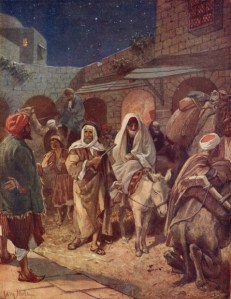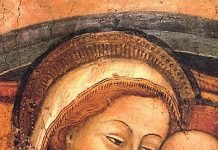With Advent beginning, I wanted to share some musical selections for this time of waiting. Some will hopefully be familiar, and others will be unfamiliar but enjoyable nonetheless.
The first selection is one that will likely be familiar to all readers. “Veni Veni Emmanuel” is one of the so-called “O Antiphons,” which are traditionally sung each day leading up to Christmas Eve. Each takes its first words from one of Christ’s titles in Scripture, primarily from prophecies, such as “O Oriens,” or (in poetic translation), “O Rising Sun,” which appear in Isaiah and Malachi. Here is a choral arrangement of the chant sung by the King Singers.
On the topic of the O Antiphons, here is a choral setting by Anglo-Canadian organist and composer Healey Willan (1880–1968). He wrote hundreds of compositions, mainly for choir or organ, but also some orchestral pieces. Often referred to as the “Dean of Canadian composers,” Willan’s “O Adonai” setting, part of a larger setting of the O Antiphons, is written in a clear, modal language, and is set in English.
The first Marian selection on this list comes from the English composer Herbert Howells (1892–1983). This is one of my personal favourites, and I’ve had the pleasure of singing this in a choir before. It is written in a modal albeit wonderfully chromatic style, with changing time signatures, which gives it a free-flowing feel that is reminiscent of plainchant. While it is slightly more Christmas in theme, at least in terms of the lyrics, there is much in the text regarding prophecies on the coming of Christ. It is a partial translation of the German Advent hymn, “Es ist ein Ros entsprungen,” as translated by Catherine Winkworth (1827–1878). The final cadence at the end of the piece includes a chord that I can only describe as shimmering, and it is perhaps one of the most beautiful pieces of choral music I have ever heard.
“Rorate Caeli” is a chant hymn, one that is frequently sung in Divine Office and Mass during the Advent season. Its refrain begins, “Drop down dew, ye heavens, from above, and let the clouds rain the Just One,” but moves into an altogether different tone, reading, “See, O Lord, the affliction of thy people, and send him whom thou hast promised to send. Send forth the Lamb, the ruler of the earth, from the rock of the desert to the mount of the daughter of Sion, that He Himself may take off the yoke of our captivity.” There are pleading moments of repentance in the text, ultimately ending with, “I will save thee; fear not: for I am the Lord thy God, the Holy One of Israel, thy Redeemer.”[i] The chant melody itself is one of simple beauty, and is perhaps one of my favourite chants.
A traditional Basque carol originally, “The Angel Gabriel from Heaven Came” is an unusual metrical hymn, for it has changing time signatures, but is nonetheless sublime. It is one of my mother’s favourites and I fondly remember singing it in the parish choir while I was in high school. Here it is, sung by the inimitable choir of King’s College Cambridge.
Our second Marian selection is also a translation of the German hymn, “Es ist ein Ros entsprungen,” although we know it in English as “Lo, How a Rose E’er Blooming” in this translation. The first verse reads, “Lo, how a rose e’er blooming, From tender stem hath sprung. Of Jesse’s lineage coming, As men of old have sung; It came, a flow’ret bright, Amid the cold of winter, When half spent was the night.” Once again, the Old Testament prophecies are appearing in these Advent hymns. The musical setting was written by Michael Praetorius, first appearing in a hymnal publication in 1599. Interestingly, this hymn has never been ‘smoothed out,’ for the music features mixed metres and syncopations, which can feel a bit unusual to our ears today. Below is a version in the original German, with a translation below, and is sung by Voces8.
I cannot resist sharing at least one Renaissance motet on this list. William Byrd’s “Laetentur Caeli” is a jubilant work, with a text from Isaiah, reading, “Let the heavens be glad, and the earth exult. Exclaim praise, o mountains. For our Lord will come, And will have mercy on His impoverished ones. Justice will arise during your days, And an abundance of peace. And He will have mercy on His impoverished ones.”[ii] The piece features flowing lines and exultant outbursts throughout the work, giving it a joyous feeling of anticipation appropriate for Advent. This recording comes to us from the excellent choir of the Toronto Oratory, also known as Holy Family Church.
Our final selection is “Conditor Alme Siderum,” an ancient chant hymn, written in the seventh century and of unknown authorship. It was substantially revised by Pope Urban VIII in the seventeenth century, leaving only one line unaltered, but the original version has since been restored to its place in the liturgy. The hymn’s title translates to, “Creator of the Stars of Night,” and is a profound hymn of juxtapositions. It contrasts light and darkness, the anticipation of Christmas and the Second Coming, and other imagery. The chant itself is syllabic, but very singable and is a beautiful example of the Gregorian Mode 4. Here is the chant sung a cappella, as well as a recent composition based on this melody by my organist-composer friend Mark Himmelman (the first piece in the video).
I hope these musical selections may aid you in your Advent journey, that they are uplifting, even if only in a small way, and that you have a blessed Christmas.
[i] “Gregorian Chant Lyrics – English Translation of Rorate Caeli Desuper – Dew Heavens Advent Traditional Catholic Hymn Song.” Traditional Gregorian chant cds. Accessed November 26, 2020. http://www.chantcd.com/lyrics/dew_from_heavens.htm.
[ii] Byrd: “Laetentur coeli.” Emmanuel Music – Motet Translations. Accessed November 26, 2020. http://www.emmanuelmusic.org/notes_translations/translations_motets/t_byrd_laetentur.htm.












